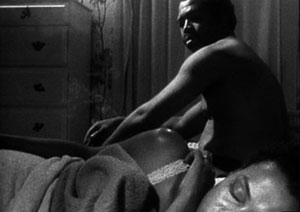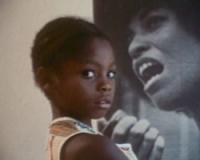The closing image of Bless Their Little Hearts is intentionally left open-ended, at least according to the director, Billy Woodberry. In an interview with Black Film Review, Woodberry explains, “I think the flight into another sort of realm—the grotesque, the ironic—that he [Charles Burnett] wrote was wonderful in some ways. But I think the current ending, not necessarily better, but better for what the film is now.” In the original script, written by Burnett, the main character, Charlie, becomes a clown, but in the final version of the film, Charlie walks away from his pals into the unknown without explanation.
We do not see his face, only his back as he grows smaller in the frame. The final image of Charlie exudes the bitter-sweet characteristics of The Little Tramp, a character that Charlie Chaplin created spontaneously and used to great affect. According to Chaplin's autobiography, “I defined to Mr. Sennett [director] the type of person he [Little Tramp] was. He wears an air of romantic hunger, forever seeking death, but his feet won't let him.”

Without knowing Burnett's intended meaning for turning Charlie into a clown, we must rely upon Woodberry's more implied directorial decision. As Woodberry explains in his oral history interview through UCLA's Film & Television Archive, “I came to believe and accept that if you want to talk about politics in film, at least for me, it was not so interesting to be so direct.”
We must decipher Charlie's future intentions via the clues within the story, of which there are many. Charlie lies to his wife, takes up with another woman, demeans his five-year-old son and preaches about the material versus the spiritual though not necessarily in this order. However, regardless of order, he is not a likable character, and yet, his struggle to find work, his pledge to his family, and the powerful moment in which he bares his burdened spirit to his wife and children gives the viewer enough reason to accept his human flaws and truly relate to him on a personal level. While it is easy to dislike him, it is equally easy to observe ourselves in him and he in us.
According to Woodberry, “my concern and Charles' concern was to speak about these people and their relationship to the world. Their problems are in many ways the defining ones—the massive unemployment, the difficulty of male-female relationships—which seem to be universal—the maintenance of the family. These are big problems. But they aren't unique to black people.”
If the unresolved ending is actually an indirect political statement using The Tramp motif, does Charlie wander to his death unable to compete in this world? Even Chaplin regretted killing his beloved character, “I was wrong to kill him. There was room for the Little Man in the atomic age.” Is it naïve to hope that Charlie gets a lucky break, like The Tramp, and wins some happiness? “With all due love and respect,” says Woodberry, “temperamentally for me, this ending is what I saw as organic to the material.”

Billy Woodberry is a prominent presence around UCLA’s film school. As UCLA students we have the unique privilege of talking to Billy. We sat down with Mr. Woodberry after viewing “Bless Their Little Hearts” to discuss both his UCLA experience and his filmmaking process and some of the deliberate choices he made in Bless their Little Hearts.
Woodberry was able to get unusually naturalistic performances from his actors in Bless Their Little Hearts.” When asked about his directing method Woodberry gave quite a bit of credit to his actors. For him, a huge portion of the directing process is casting. He looked for actors that were intelligent and with who he felt a strong bond. He also sought out actors that possessed a strong work ethic and were not concerned with breaking into Hollywood.
Once cast, Woodberry worked to build a trusting bond with him and his cast. He wanted his actors to know that would not do anything that would harm them and would be working to make them look good. He also trusted his actors to bring more to the table than he had originally envisioned. He would show up to rehearsal with a strong idea in mind about what he wanted from the performance and inevitably the actors would add a new layer which he accepted as part of the collaborative process.
Woodberry also talked about working with children. He claimed that with children creating a co-conspirator relationship in the child actor helped smooth the relationship between director and actor. He would tell the young actors things that only they were privy to, giving them a sense of privilege on set. This method would get the children involved in the part, preventing the long hours of shooting (often 12 hour days) from hurting their performances. He also allowed the children’s playmates to come to set to help keep them entertained during the hours in which they were not performing.
A calm set was an important factor for Woodberry. He believed that an air of calm allowed all of his actors to perform in a realistic way. While both Woodberry and Charles Burnett (his cinematographer) experienced high levels of stress on set, they worked hard to never let his actors know that anything was worrying them.
After discussing his directing method, Billy described the path he took while at UCLA. Woodberry spoke of all the converging factors that led him to be a student in the film department. Before studying film, Woodberry was a Masters student in the Latin American Studies department studying history, political science, and political study. He recounts one class in which they surveyed Cuban history and society through the films Cubans were making. In his words, he found the films “moving, highly inventive, and striking in their method of addressing social problems through movies.”
Also a factor was the social climate of that era. The post Vietnam era was replete with individuals and groups that engaged in stimulating discussions around capitalism, socialism, third world cinema, radical world cinema, etc. Woodberry was exposed to the writings of Richard Wright and French filmmaker Jean-Luc Godard as well as early Soviet Cinema. Through pursuing further exposure to this non-traditional world of film, Woodberry found other people that shared his developing views.
As a young filmmaker at UCLA, Woodberry also spoke of the mandate coming from those that came before him. People like Charles Burnett and Larry Clark, for example, made it clear that film school was not a place of toil. That is, there was a charge to set a good example and to not mess up the opportunity for anyone else. Therefore, Woodberry took his craft very seriously while a student at UCLA and adhered to the code of ethics coming from his mentors in the group and the UCLA film community.
—Dawn Spinella, Moana Sherrill and Iyabo Kwayana






 Mobile Navigation
Mobile Navigation

